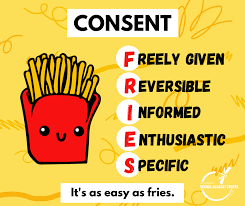We all know that only yes means yes when it comes to consent -- but what does consent mean in reality? We are going to break it down.
As a reminder, California law says that consent is when someone says yes with their own free will. That means they must be acting freely and voluntarily and fully understand what’s happening and what they are doing. Someone under the influence of drugs or alcohol is not able to give consent. Put another way, to give full consent, someone has to be sober.

Consent FRIES!
We can think about FRIES when we think of consent. This helpful acronym explains all of the aspects of consent:
Freely Given: Consent should be given without pressure, force, or under the influence of alcohol or drugs.
Reversible: You can change your mind about what you want to do at any time -- even if you are in the middle or have done it before.
Informed: You should know exactly what you are giving consent to. For example, if someone says they are going to use a condom and they don’t, they didn’t have your consent.
Enthusiastic: Someone should be excited to give consent. If someone is not sure, it is always better to wait. Pay attention to body language as well as what the person is saying and how they are saying it.
Specific: Saying yes to one thing does not mean you have said yes to other things. Consent should be given at every step.
Tips for asking for asking for consent
There are a lot of ways to work consent into the moment. Ask questions along the way like “should I keep going?” “how does this feel?” or “what would you like me to do next?”
You can also say what you would like to happen and allow your partner to respond. For example, “I would like to kiss you now. Is that ok with you?”
Come up with some ideas for how to ask for consent that work for you and practice them beforehand! Asking for consent when you are with your friends or family is great practice!
Tips for giving consent
If someone asks you for consent, first decide if it is something you want to do or not. Remember, it is always ok to say no. If you are unsure, you can always say no first and change your mind later if you decide you want to give consent to something. You can also share your limitations. You can say “yes, but…” to anything! Once you have decided if you want to say yes or no to something, you can do so enthusiastically. You can also ask your partner for consent as well. If someone is not asking for consent, you can stop and remind them or give them consent anyway. If you do not want to continue, tell them that.
Consent is more than words
Remember that consent must be enthusiastic. No matter what your partner is saying, think about how they are saying it. An enthusiastic yes might mean an excited tone of voice, positive body language, or initiating the next step. If someone is saying yes but they seem hesitant or unsure, it might be time to slow down. Someone should be saying yes with their voice, tone, and body language. When in doubt, slow down, double check, or stop. Your partner should appreciate you taking their feelings into account, go slowly and respect their boundaries. If your partner is under the influence of alcohol or drugs or for some reason might feel coerced, that is definitely a sign to slow down or stop.
What happens if someone does not consent?
If someone does not actively consent, you should stop. Continuing without consent can be considered rape or sexual assault. If you did not give consent and your partner continues, ask them to stop. Leave the situation if needed. If you or someone you know has experienced sexual assault, find help near you.
Consent is required in sexual situations but can also be important in other moments, too. You would ask for consent before borrowing something of someone’s or sharing information they told you with other people. Practicing consent in everyday situations will make it easier when you have to ask for consent in a sexual situation.